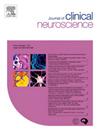Risk factors contributing to polyneuropathy in chronic hepatitis B: a cross-sectional perspective
IF 1.8
4区 医学
Q3 CLINICAL NEUROLOGY
引用次数: 0
Abstract
Objective
During the course of chronic hepatitis B (CHB), polyneuropathy (PNP) may occur. The purpose of this study is to investigate risk factors and determine the frequency of PNP in CHB patients who have complaints such as pain, paresthesia, and numbness.
Method
The data of 350 CHB patients who presented to the neurology outpatient clinic with symptoms suggestive of PNP were retrospectively analyzed. Sociodemographic and disease-related data and nerve conduction studies (NCS) results were obtained from hospital records.
Results
PNP was found in 59 out of 350 patients. Out of these individuals, 72.9 % had axonal PNP and 27.1 % had demyelinating PNP. High hepatic activity index (HAI) score (OR = 2.74, 95 % CI: [1.63;4.72], p < 0.001), HBeAg-negative CHB (OR = 5.46, 95 % CI: [1.78;16.87], p = 0.003), male gender (OR = 7.53, 95 % CI: [3.71;15.91], p < 0.001), and advanced age (OR = 1.07, 95 % CI: [1.03;1.10], p < 0.001) were identified as independent risk factors linked to PNP. Male participants were significantly more common in the axonal PNP group (p = 0.003), while female participants predominated in the demyelinating PNP group. Disease duration was significantly longer in the demyelinating PNP group (p = 0.025). The Ishak Fibrosis Score (IFS), which reflects the severity of fibrosis, was significantly higher in the axonal group (p < 0.001).
Conclusion
Our results reveal that male gender, high HAI score, advanced age and HBeAg positivity are risk factors for PNP in CHB. Male patients who have severe liver fibrosis face a higher likelihood of developing PNP, characterized by substantial axonal damage. Conversely, female individuals with a prolonged history of CHB are susceptible to demyelinating injury. Consequently, it is advantageous to inquire about PNP problems in CHB patients during their routine examinations and, if warranted, to arrange a NCS and provide guidance for diagnosis and therapy.
慢性乙型肝炎多发神经病变的危险因素:横断面分析
目的慢性乙型肝炎(CHB)病程中可出现多神经病变(PNP)。本研究的目的是探讨有疼痛、感觉异常和麻木等主诉的CHB患者发生PNP的危险因素和频率。方法回顾性分析在神经内科门诊就诊的伴有PNP症状的350例CHB患者的资料。社会人口学和疾病相关数据以及神经传导研究(NCS)结果来自医院记录。结果350例患者中59例出现spnp。在这些个体中,72.9%的人患有轴突性PNP, 27.1%的人患有脱髓鞘性PNP。高肝活动指数(HAI)评分(OR = 2.74, 95% CI: [1.63;4.72], p <;0.001), HBeAg-negative慢性乙肝(OR = 5.46, 95% CI: [1.78, 16.87], p = 0.003),男性性别(OR = 7.53, 95% CI: [3.71, 15.91], p & lt;0.001),和先进的年龄(OR = 1.07, 95% CI: [1.03, 1.10], p & lt;0.001)被确定为与PNP相关的独立危险因素。男性参与者在轴突性PNP组中更为常见(p = 0.003),而女性参与者在脱髓鞘性PNP组中占主导地位。脱髓鞘PNP组病程明显延长(p = 0.025)。反映纤维化严重程度的Ishak纤维化评分(IFS)在轴突组显著升高(p <;0.001)。结论男性、高HAI评分、高龄、HBeAg阳性是CHB患者发生PNP的危险因素。严重肝纤维化的男性患者发生PNP的可能性更高,其特征是轴突损伤。相反,长期CHB病史的女性个体容易发生脱髓鞘损伤。因此,在CHB患者的常规检查中询问PNP问题是有利的,如果有必要,安排NCS并为诊断和治疗提供指导。
本文章由计算机程序翻译,如有差异,请以英文原文为准。
求助全文
约1分钟内获得全文
求助全文
来源期刊

Journal of Clinical Neuroscience
医学-临床神经学
CiteScore
4.50
自引率
0.00%
发文量
402
审稿时长
40 days
期刊介绍:
This International journal, Journal of Clinical Neuroscience, publishes articles on clinical neurosurgery and neurology and the related neurosciences such as neuro-pathology, neuro-radiology, neuro-ophthalmology and neuro-physiology.
The journal has a broad International perspective, and emphasises the advances occurring in Asia, the Pacific Rim region, Europe and North America. The Journal acts as a focus for publication of major clinical and laboratory research, as well as publishing solicited manuscripts on specific subjects from experts, case reports and other information of interest to clinicians working in the clinical neurosciences.
 求助内容:
求助内容: 应助结果提醒方式:
应助结果提醒方式:


